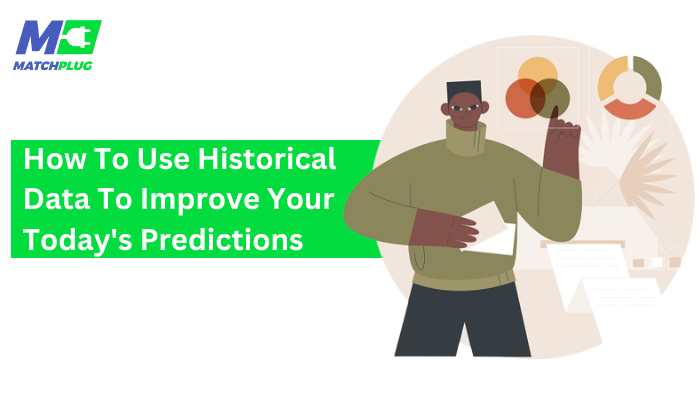Correctly predicting the outcome of a match is a difficult task, but the use of historical data to examine matches closely before making a decision can significantly improve the accuracy of your prediction. In this article, we discuss extensively, How to Use Historical Data to Improve Your Today’s Predictions.
There are certain metrics you look for when using past data of a team to back up your Todays Prediction these often include player and team statistics which in turn translate to points scored, rebounds, goals scored, shots on target, etc. in previous matches.
This whole process involves taking a look into a team or player’s past to understand better how to predict their future in an upcoming matchup. Understanding their past helps you recognize patterns which they are bound to repeat in all their performances, so that you know which wagers work best for them or if you should completely ignore them.
As we go along, we’ll discuss historical data – its importance, types, examples and how to use them to make predictions.
Read – How to Analyze Past Performances to Improve Your Correct Score Predictions
Table Of Content:
- What is historical data and how is it used in sports analysis?
- Importance of historical data
- Sources of historical data
- Examples of historical data for today’s predictions
- Types of historical data for today’s predictions
- How to use historical data to make today’s predictions
- Limitations of using historical data to improve your today’s predictions
What Is Historical Data And How Is It Used In Sports Analysis?
Historical data defines the past performance data of teams or players that can be used to predict future performances.
In sports analysis, historical data is used to analyze and predict match outcomes, player performance, and team strategies.
One popular method of applying historical data in Prediction Today is the use of statistical modelling. These models use historical data to recognize patterns and trends in team or player performance and use those patterns to make decisions about future matches. Some common statistical models used for sports analysis include regression analysis, decision trees, and neural networks.
Importance Of Historical Data
Historical data is essential to predicting the result of a game. When you analyze previous matches you have a higher chance of identifying patterns and trends that can help you make better predictions.
One of the main benefits of applying history to your today’s predictions is that you can easily assess individual players’ and teams’ performance over time. You can further learn their strengths and weaknesses to make adjustments when needed.
Furthermore, past data offers insights into the playing style and tactics of different clubs. This helps you understand their preferred formations, strategies and playing patterns.
See also – Football Prediction And Statistics – A Partnership With Incredible Results
Sources Of Historical Data
There are lots of places you can find historical data which can be valuable to your predictions. We have mentioned two of the most accurate sources to find past data.
Official Websites Of Leagues And Teams
The website of a league or team is one of the surest sources to find historical data. For instance, the NBA Stats offers access to previous records of each team and player on their website. This includes statistics that date back to the league’s inception in 1946.
Likewise, the NFL Stats also provides past data on their website, which contains play-by-play for every match from 2023 back to 1999.
Third-Party Sports Providers
Sports providers gather and group historical data gotten from different sources and give bettors access to this information using APIs or other delivery methods. Some providers to check include Stats Perform, Opta, and Sportradar.
Examples Of Historical Data For Today’s Predictions
There are two examples of historical data that can be used for predicting the outcome of a match. They are player and team statistics, and head-to-head records. We explained them below:
Player And Team Statistics
Player and team statistics include metrics like points scored, rebounds, assists, and shooting percentages for the NBA. While for soccer it would be goals scored, shots on target and passing accuracy.
By evaluating these stats, you can recognize patterns and trends in the performance of a team or athlete, and use them to predict future matches.
Head-To-Head Records
Analyzing head-to-head records would mean looking at the results of all the previous matches between two teams or players, and identifying recurring events in the way these two sides compete against each other.
Read also – Breaking Down Sports Stats To Make Better Predictions
Types Of Historical Data For Today’s Predictions
Various types of historical data can be used for today’s predictions. They include:
1. Match Statistics
Match statistics are data for the number of shots, ball possessions, corners, and fouls by both teams. Evaluating these stats teaches you the playing style of each team, including their strengths and weaknesses.
2. Athletes And Team Records
Athletes’ and teams’ records are the result of team and player performance over a period. It gives insights into the behaviours, strong areas and weak points of teams and players.
3. Rankings
Rankings often measure the performance of each national team. Analyzing rankings helps you master the specific strengths of different clubs so that you can predict accordingly.
4. League Tables
League tables give you an overview of the performance of different clubs in a specific league. Records you’ll find in a league table includes – wins, losses, goals, total points, etc.
How To Use Historical Data To Make Today’s Predictions
The use of statistical models and machine learning algorithms is one way you can use past data to predict match results. These models use different variables like team form, player statistics, and team performance to create the probability of an outcome.
Some popular models dominant in this approach include logistic regression, decision trees, and neural networks. You can train these models on past data to make them more accurate with time. Additionally, sports prediction sites used these models to set odds for upcoming matchups.
We have explained two of those statistical models below:
1. Regression Analysis
This is a technique that identifies the relationship between variables. Regression analysis can be used to find the factors that are most strongly correlated with match results.
2. Decision Tree Learning
Decision tree learning is a machine learning technique that identifies patterns and relationships in past data. This pattern highlights factors that are most associated with match outcomes.
Related: How To Leverage AI For Sports Predictions That Are Data Driven.
Limitations Of Using Historical Data To Improve Your Today’s Predictions
Historical data analysis can be an effective tool for predicting the outcome of matches, but it still has its limitations. We’ve shared these limitations to be aware of below:
1. Unforeseen Events
One main challenge of using past data is that it cannot factor in unforeseen events during a game like injuries, red cards, or changes in weather conditions. Even after you cover all your bases before making a prediction, these variables can suddenly spring up and affect your bet.
2. Quality And Quantity Of Data
The predictive accuracy of statistical models can vary widely depending on the quality and quantity of data during their training. They’ll make their forecasts based on only the information given at the time of the analysis.
3. Availability Of Data
Not all leagues or teams may have comprehensive data readily available, or what they have may be incomplete or inaccurate. It also may not cover the specific historical moments that you need for your predictions.
Wrap Up:
Historical data can be an excellent tool for bettors, sportsbooks, and tipsters to make today’s predictions. By applying the statistical models associated with it, you can get correct probabilities for specific outcomes based on different significant variables.
However, do not overlook the limitations associated with this approach and ensure you constantly monitor and adjust your predictions based on new information and unforeseen events.
Explore Similar Topics
Understanding The Factors That Affect Today’s Predictions












1 Comment
Jane Njoku
February 6, 2025 at 2:27 pm[…] When performing research, we ensure that we consider factors that could affect the outcome or trajectory of a match such as – team performance, injuries, weather conditions, player statistics, and historical data. […]